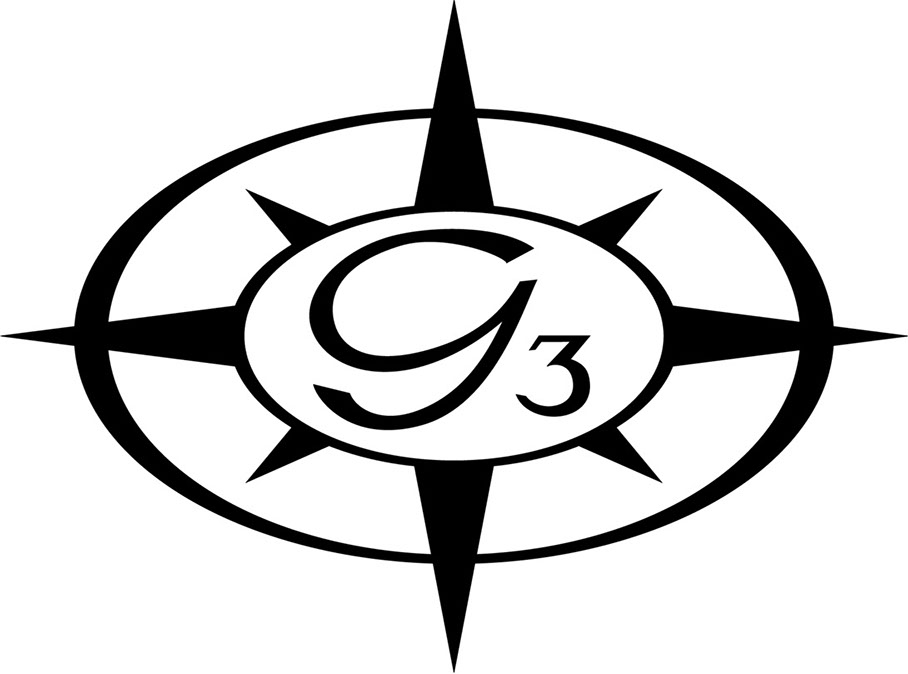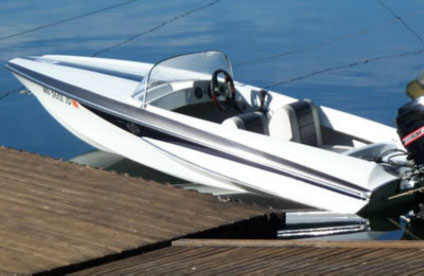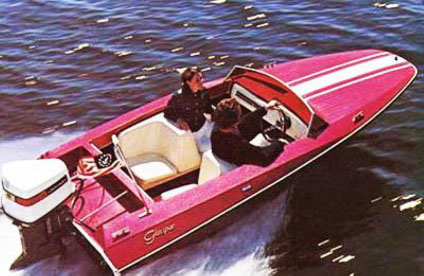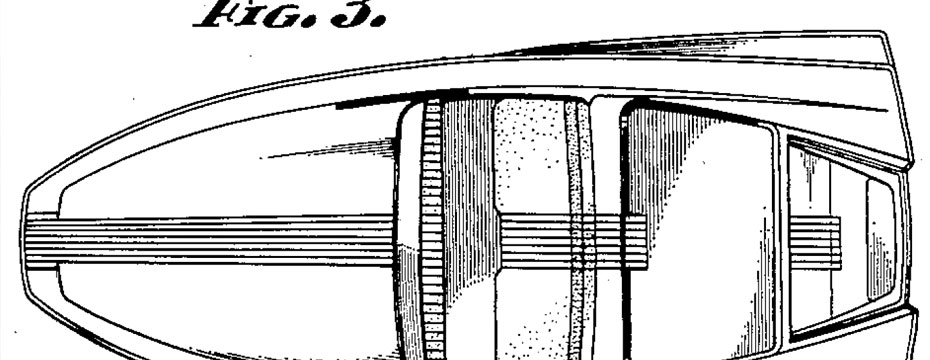G3 Owners Association
www.G3owners.com

The Glasspar G3
by Karl Beisel, 1990
The G-3 name:
How was the G-3 named "G-3?" Per Bill Tritt (the founder of Glasspar), at the time (1959) the U.S. Military had a missile called the G-3. Glasspar picked up the name from the missile.
How many G-3's were made?
This is extrapolated from info Bill Tritt gave us. Glasspar made a total of 16,000 boats in 1960 (this is a known number). We assumed 8 models evenly divided (remember the G-3 was not made in 1964). We assumed slowing production of 5% per year thru 1968. Values are: 3,500 Center Deck models and 8,700 Open Decks. There is a margin of error here of up to 30% or so. Our numbers are likely somewhat high.
When fiberglass was new:
Glasspar had to give dealers incentives in the early 1950's as fiberglass boats were very new and considered "plastic" boats. Dealers were concerned that since they were plastic, they would break!
The boat:
There were two separate models (three counting the redesign by Larson-see more below). Both hulls were the same, only the decks changed. The beginning manufacture date is 1959 on the west coast, 1960 in the east. The models are normally referred to as:
Center Deck Model (1959-61); with one bench seat. The earliest models had a snap-in-pad in the rear compartment.
Status symbol:
Low or early state registration suffix e.g. VA 8592 B <---. Most states are now into double letter suffixes. You might find that in states that never reissue numbers (VA is one) that old boats with latter day numbers may be carried on their records twice (old and new numbers).
Current value:
I'm often asked about the value of a restored G-3; or one in very good condition, and even neglected disasters. Unfortunately, such boats are a very narrow interest and there is little added antique or collectable value. The boats are worth what any other usable boat is worth or, more appropriately, what a buyer is willing to pay. I do know that in 1990 a 1965 G-3 with a like year 65 hp Merc and trailer, all in showroom-original condition sold for $2,800 (to a collector). This boat had been garaged since new and had (literally) not left that garage in 17 years. There is not a big demand for 13 foot boats old or new. Most disasters sell for $100-200 (boat only) and the others in between.
Restoration:
The weak link in the boat's structural longevity is its transom (and stringers). The rear side decks were designed so as not to actually cover the entire transom. The transom's plywood reinforcement (4 layers of 3/8" plywood) was neither painted nor fiberglassed leaving it exposed at the top. The rear side decks are not structurally connected to the transom. A small aluminum trim piece covers the joint and (gasp!) actually directs rain water to the top of the transom's unprotected wood. You will often find that boats stored exposed to the elements have rotted transoms 4 to 5 vertical inches from the top all along the area where the rear deck joins the transom. The area beneath the motorwell is normally in better shape principally because the rear side decks (or other structure) do not funnel rain or spray to the wood. But it is bare wood (on the top) as well. The transom's plywood reinforcement runs all the way to the outer corners of the sponsons. The transom plywood face (inside the sponson) was not covered with fiberglass (it is bare wood). As the sponson rails leak, the plywood absorbs the water and it eventually rots.
The flooring (1/4" plywood) was covered in fiberglass only on the top. The bottom side is bare wood and normally it will rot from the bottom up or underside if water remains inside the inner hull for any length of time.
Windshields:
Most G-3's lost their windshields many years ago. It is unfortunate that they have lost this finishing touch. There were two versions. The first was for the earliest center deck model. Its windshield's top edge, has a slight slope from centerline to the outside edges. A second design, used on later center deck models (and open deck models as well) was nearly flat across the top edge. All originals were clear and were made by Taylor Manufacturing. They are no longer available. I've checked with the company. An updated version, actually made for a 1972 Larson model, is available from Larson for $95.00 plus about $6.85 shipping. The windshield fits open deck model fairly well but not perfectly (it may be too wide for the center deck boats). The misfit is primarily at the corners where a small gap exists on the inside as the Plexiglas doesn't make the turn as fast as the boat's raised windshield-deck segment. The windshield may also be a little wider than the deck's "windshield shape." But it is a nice finishing touch and the "update" fits the G-3's styling. It's also available in "smoked" colors. Larson Boats, 702 Mississippi River Drive, Little Falls MN 56345 or phone 612-632-5481 (ask for customer service).
It is fairly easy to make a custom windshield using 3/16 or 1/4 inch Plexiglas. The unshaped Plexiglas cost about $35.00. Chris Beisel has made several. Suggested is a windshield 14 inches tall. When initially cut the plexiglass is straight across the top, and has a slight curved across the bottom. It is bent (cold) to the shaped of the deck-windshield-contour but is heat shaped at both ends. 3/16 or 1/4 Plexiglas is relatively easy to heat shape at the ends. It can be heated over a kitchen stove and press (still hot) against the boats windshield contour. See those windshields in some of the photos.
Answers to typical questions:
Finding a G-3 is relatively easy. The best place to look is locally. Scan the used boat papers regularly. One will eventually show up. Also... advertise in on routinely scan the Antique and Classic Boat Society's quarterly (title: Rusty Rudder) publication. Check the owners lists for noted buyers and sellers. Or advertise locally or in Hemmings Motor News. Pristine perfect boats can be found but it does take time. I have found three. All 35 years old but virtually showroom perfect.
Hardware parts are not available. Your best bet may be to find a another boat in disastrous condition and cannibalize some of its parts. There are quite a few around but finding them is a task.
There was a picture of a golden-yellow early 1960 model on the back cover of Popular Mechanics in April-June 1960. I have never actually seen anything but all white center deck models with red or black trim stripes down the deck and the panel on the side in matching color.
I do not believe there is any antique value to the boats even restored other than the value to the owner.
Its monetary value is what ever the market will bear. There are enthusiasts around who would pay a slight premium but not much more than any similar size boat in like condition. Disappointing I know but true. I do not believe custom features make a difference in value. There are "Purists" who like to keep them totally original but it's up to the individual. Having fun doing what you like to do is most important.
Good combinations: The 55 hp two cylinder OMC engines are nice power and within the G-3's hp rating. The 55's are available with 15" inch shafts so no transom alterations are necessary. A 115 hp OMC will run it in the high 50's (mph). But they are heavy and you'll need to be sure the transom is strong, also that it is at 20 inches. The boats were made with 15" transoms but today all motors above 50 hp come with 20 inch shafts. Probably the best combos are 55 hp OMC's, 3 cylinder Mercs, or older 4 in-line Mercs. All are relatively light for their power.
Refinishing is quite a job and there are a lot of trade offs. Problem is the best paint, two part polyurethane is toxic and cannot be sprayed by an amateur. You need a "space suite" fresh air input to use it. Paint alone will also cost $200+. Two part polyurethane can be brushed on economically. Interlux paints describes this and mentions thinning the paint so that it will "flow out." This approach would be much cheaper. Views here differ. My own philosophy is to be economical. I don't know the answer. I used Interlux one part polyurethane (the none toxic variation). There are a few who have done beautiful restorations with high tech sprayed on paints (Tom Dreiling, Steve Kujawski, Steve Zurowski).
Some boats have a problem with porpoising (continuous bouncing). Many of Glasspar's boats (G-3 included) had a raised center bottom portion designed to cause the boat to hold its bow up and "rock back toward the transom" while under power. This was a 1950's technique of getting the boat out of the water and increasing speed and efficiency. The last two or so feet of the bottom must be flat. It is my belief that mold defects or short curing time caused slight bottom imperfections. If you have a porpoising problem you may need to flatten out the last six inches of the bottom right before the transom. Even a 1/4 inch rise can cause a bounce.
Today's designs accomplish efficiency with a flat longitudinal pad about eight inches in width running most of the length of the boat alone the keel. If you have a bounce trim and tilt can help manage it. As speed increases you may be able to "trim through the bounce" positioning the boat so that it rides on the very back portion of the bottom where there may be no distortions.
To get the boat really moving, the engine needs to be mounted so that the cavitation plate clears the water while moving fast. Otherwise, if at a tilt angle it can act as a brake. This alone is worth 3-5 mph.
Trim and Tilt is a very desirable feature and will enhance manipulating the boat's performance and speed. If you have a bounce, trim can help you get beyond it to a higher speed where the bounce may stop.
Experienced Performance Capabilities (light loads and one in the boat):

*note by Dean Lofall:
In 1959, the G3 didn’t have the same HIN scheme or the nameplate on the port side as did the 1960 and later boats. The HIN was stamped on a round disc (like a rudder zinc half) and located on the port side up under the center deck. The HIN is decoded as follows for my boat:
HIN# G3A9225
G3 = Model# G3
A = Santa Anna, CA plant
9 = 1959 model year
225 = 225th hull of model year run produced
Other HINs in 1959 and 1960 model years have been found to be stamped on the center deck support base trim.
G-3 factory specifications:
Length: 13'7"
Weight: 390lbs
Rated: 60 hp.
Manufacture date:
This information (although not emphatically verified) holds true on 5 boats. Note that bills-of-sale, and state registrations are notorious for being incorrect on model year. If you still have the boat's Hull ID tag, you can easily tell. There are several versions of the tag. The first is a small chrome plate about two inches wide and one inch tall. It says "Glasspar" and indicates in tiny letters indicates the four or five factory locations (Santa Ana CA; Olympia WA; Nashville TN; Petersburg VA; and a Texas location added later… city unknown). It is attached to the inside of the left side-deck (the passenger's side). There's a slot in the plate and behind it a brass plate with numbers. Early boats (beginning in 1960) had numbers beginning with 13 X.... Numbers such as 13 XP 1253 indicate the 253rd boat in 1961. The first digit after the P (manufacture location: Petersburg VA) indicates model year. A second version of the tag was gold and black in the same location and began with 13 G..... Thus, G-3's with numbers such as 13 GT5 0401 are 1965 models. The first digit after the T indicates year. T (we believe) indicates Texas. Location designators for 1965 and later are T (Texas) V (Virginia) W (Washington) C (Calif.) N (Nashville TN) (P: Petersburg VA is used prior to 1965). Location designators changed from the 13 X numbering system in 1965. Another number system was used in 1959 and still another beginning in 1966. If your tags are missing, there are a few other tips. If you have a center deck model, and it has a hump-like footrest molded under the bow it's a 1961. If not, and you can see the contour of the hull's center-keel (under the bow) it's 1960. The Glasspar name was attached to the rear sponson in early 1960 model (made in late 1959) and shifted to the center deck supporting strut in 1960 and 61. If you have an open deck, and it has a sump-like fixture centered in the floor at the transom, it's a 1965 or later. Some models have metal trim pieces that follow the dash board edges. We believe this was a 1967-only feature. Carpet was used (we believe) only in 1968 which was its last year.
Open Deck Model (1962-67 or 68); matching buckets seat (for 2) in 62-63. The passenger's side flipped backward and was billed as the "flip back ski observer seat." 1965 and beyond were back to back seats for four. The G-3 was not produced in 1964.

Catalina G-3: Larson later produced a 14 foot boat of totally different molding entitled the "Catalina G-3."

If you are still confused, write your state's boat registration department. Give them the boat's registration number (the one on the bow issued by the state) and the hull ID number. Ask for a copy of every owners' registration form since the boat was registered. Chris Beisel's boat was traced right back to 1961 through 7 owners. The same technique also works forward in time. For example, if you owned a G-3 years in the past, you may be able to trace it to its current owner. You could restore the boat you previously owned. Many have become "backyard derelicts" and can be bought for a song. A handy tip here: as long as the boat is registered, a trail exists. It's not so easy if it has changed hands several times and the registration expired. Unfortunately, this is commonly the case. It is unlikely such boats have seen continuous use of 35 years.
Interesting engineering:
One of the most fascinating points about the boat, was how it was made. The sponson’s cantilevered position would not allow the hull to be molded in one piece. Thus the top half of the sponsons were added after the hull was removed from its mold. The fascinating part is that there is no indication of any seams. But notice the sponson-transom-area "L" shaped trim piece combination. It's actually a horizontal and vertical seam cover. The sponson rail covers the longitudinal seam and the "G-3" medallion covers the forward vertical line. It's really quite ingenious!
| Power | MPH | Shaft | Transom |
Note |
| 75 hp | 43mph | 15" | 17 1/2" | 1960 V4 Evinrude |
| 135 hp | 60mph | 20" | 22" | 1973 V4 Evinrude W/T&T & Jackplate |
| 55 hp | 34mph | 20" | 22" | 1/2 1978 2cyl Evinrude W/T&T |
| 70 hp | 43mph | 20" | unknown | 19xx 3cyl Evinrude W/T&T |
| 95 hp | 55mph | 15" | 19 1/2" | 1963 L6 Merc W/T&T (Model 850 modified -
Dean Lofall) |

Contact us: info@g3owners.com
© 2014 - G3Owners.com - All rights reserved. Photographs are property of their respective owners. If your boat photograph ended up on this site and you dont want it here please contact us and we will remove it immediately!